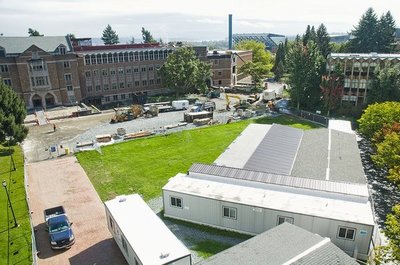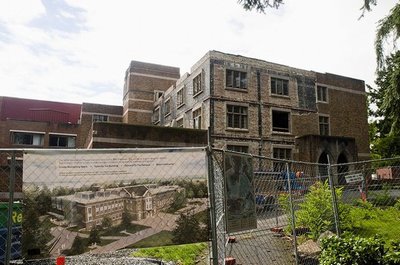September 30, 2010
Campus in 2010 is one big construction zone (and that’s a good thing)
If it seems as if the campus is one large construction site right now, that’s because it is.
“I’ve been here almost 10 years and this is by far the busiest we’ve been in those 10 years,” said Richard Chapman, associate vice president for capital projects. It’s the job of Chapman and his crew in the Capital Projects Office to oversee all new building on campus, and right now they’ve got a lot of it.
Look around the Seattle campus and you’ll see:
- A Molecular Engineering Building rising across from the Architecture Building, where Cunningham Hall and Johnson Annex used to be. Cunningham Hall was relocated to a site near Parrington Hall, and staff are moving back into a much-improved building.
- Two of four planned student residence halls under construction on West Campus.
- A new eight-story tower being built at the medical center.
- A renovated and rebuilt Husky Union Building taking shape on the site of the old one.
- A renovation under way at Hall Health Primary Care Center.
- A portion of the J Wing at the Health Sciences Center being restructured to meet the needs of the Microbiology Department.
UW Tacoma also gets in on the act, as they are renovating the Joy Building, converting an old warehouse into academic and teaching space.
Other projects aren’t yet under way but will be soon:
- Balmer Hall will be torn down later this fall and a new building built on the site. Fencing is being installed around this site now.
- Design work is being completed on a new Ethnic Cultural Center.
- Also in the design phase are a new Jefferson Street Building at UWT and phase three of UW Bothell’s campus — a science/mathematics/engineering/technology building
The College of Engineering also hopes to get approval to construct at least the exterior shell of Molecular Engineering’s phase two, with construction starting early in 2011. And there’s a non-UW construction site to consider — the 6-acre Sound Transit station site next to Husky Stadium.
All the UW projects are what is known as major projects, meaning they cost more than $5 million, the level at which individual approval of the Board of Regents is required. But there are smaller projects under way too. For example, the area in Hutchinson Hall that formerly contained a swimming pool is being made over into a design studio. (See our story here.) The site is unfortunately right across the street from Balmer Hall, but the two projects shouldn’t overlap too much, since drama hopes their studio will be ready to go by the end of the quarter.
While it may seem odd that so much construction is going on at a time of budget cuts, Chapman said most of the projects have been in the works since before the economy hit the skids. “We require a two-year design process in advance of doing construction, and in the case of some state-funded projects, they’ve been in the pipeline for four years and more before we get to construction,” he said. “So what we’re doing now are things that were authorized two, three, four years ago.”
And it’s fortunate that the actual building is happening now, Chapman said. Prices for construction peaked at the end of 2008 and are now 15 to 20 percent lower than they were then. As a result, the University is getting the construction done for about the same price it would have paid in 2006.
“We’re just about the only work out there for construction these days, and contractors are being very sharp in their bids,” he said.
Construction inevitably causes some disruption for the campus community. Building occupants are moved to other locations and the large pedestrian population is forced to maneuver around a fenced-off site. Nowhere are these things more of an issue than with the HUB. The building is being completely overhauled, and most of its services are now located in Condon Hall (see our story here), which to many seems remote. And the construction site it’s become is right smack dab in the middle of campus, now cordoned off by 2,000 feet of chain link fence.
Does it really have to take that much space? Well, yes. Chapman said the footprint of a construction site is determined by bringing the contractor together with a UW construction manager as early as possible in the process. Together, they look at matters such as whether a tower or a mobile crane will be used, how many subcontractors there will be and what kind of trailer space they will need and what dangers the work might present to passers-by. Fencing off the area is all about safety and security. As the HUB job progresses and various tasks are completed, the fenced area will shrink, Chapman said.
As for the services usually found in the HUB, well, Condon Hall is only a few blocks away, and you can even take a bus there. The current construction boom won’t last forever, of course. The bulk of it will be over by the fall of 2012. And that’s one of the most difficult things about it for Chapman.
“The challenge for us is not staffing up any more than we absolutely, positively need to to get the job done in a timely fashion,” he said. “The reason is that if we look out, our projects have such a lead time that the pipeline is unclogging very quickly. So if I look out two years from today, there’s very little construction going on — at least on big projects.”
Chapman doesn’t want to hire people only to have to lay them off two years down the road. So everyone in Capital Projects is working extra hard right now. “It’s just the way it is with design and construction,” said Steve Tatge, one of the project managers in Capital Projects. He noted that the situation was similar when he worked outside the University.
Right now, Tatge is nearing the end of his work managing the Cunningham Hall and Paccar Hall projects, both recently opened for business. He’s the project manager for the Molecular Engineering Building and for the building replacing Balmer Hall. And he’s working with individual researchers regarding the build-out of their labs in the Molecular Engineering Building.
Other project managers are carrying similar loads. “I feel some pressure but it’s not undoable,” Tatge said. “This is a good problem to have.”




